
Pimelea spicata, commonly known as the spiked rice flower, is a flowering plant in the family Thymelaeaceae and is endemic to New South Wales. It is a slender plant with white flowers and elliptic leaves.
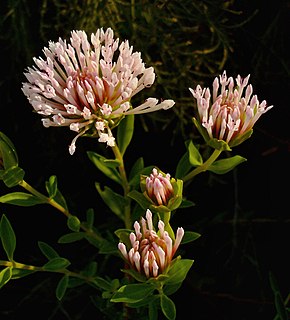
Pimelea calcicola is a species of flowering plant in the family Thymelaeaceae and is endemic to part of the west coast of Western Australia. It is an erect to spreading shrub with elliptic leaves arranged in opposite pairs, and head-like racemes of pale to deep pink, tube-shaped flowers surrounded by leaf-like involucral bracts.
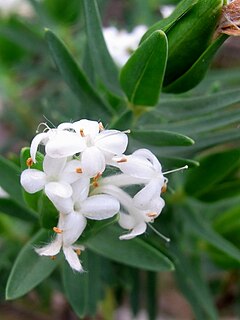
Pimelea congesta is a species of flowering plant in the family Thymelaeaceae and is endemic to Lord Howe Island in Australia. It is a shrub with rough bark, decussate, elliptic leaves and heads of white flowers.
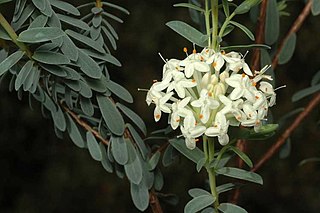
Pimelea ciliolaris is a species of flowering plant in the family Thymelaeaceae and is endemic to a restricted area of New South Wales. It is a stunted shrub with narrowly elliptic leaves and heads of densely hairy, cream-coloured to pale yellow flowers.

Pimelea sericea is a species of shrub in the family Thymelaeaceae. It is native to Australia, specifically Tasmania. Their common name is mountain rice flower. Pimelea means fat and sericea means silk. The reason could be that Pimelea species usually have oily seeds and fleshy cotyledon. The sericea came from the fact that they are covered with silky hair.
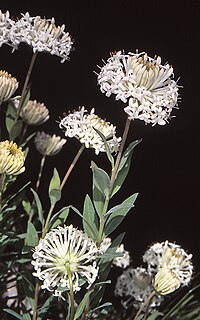
Pimelea treyvaudii, commonly known as grey rice-flower, is a species of shrub in the family Thymelaeaceae. It has white flowers in spherical heads at the end of branches and is endemic to eastern Australia.

Pimelea curviflora, also known as curved rice-flower, is a shrub in the family Thymelaeaceae and is endemic to Australia. It is a small, hairy shrub with greenish-yellow or red tubular flowers.
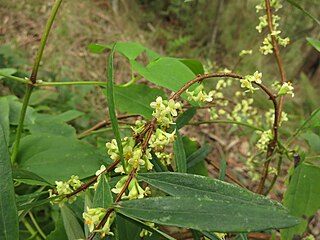
Pimelea axiflora, commonly known as bootlace bush, is a small shrub in the family Thymelaeaceae and is endemic to Australia. It is a small shrub with whitish flowers on mostly smooth stems.
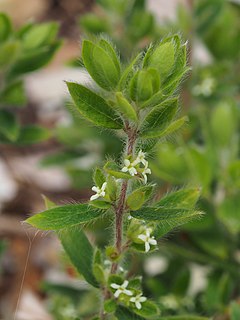
Pimelea venosa, commonly known as Bolivia Hill rice-flower, is a flowering plant in the family Thymelaeaceae and is endemic to a restricted area of New South Wales. It is an erect shrub with densely long-hairy stems and leaves, elliptic to lance-shaped leaves and small groups of white flowers.
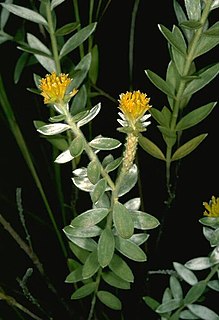
Pimelea amabilis is a species of flowering plant in the family Thymelaeaceae and is endemic to northern Queensland. It is a small shrub with narrowly elliptic or elliptic leaves and spikes of hairy, yellowy-green or yellow, tube-shaped flowers.
Pimelea aquilonia is a species of flowering plant in the family Thymelaeaceae and is endemic to far north Queensland. It is a shrub with narrowly elliptic leaves and small clusters of hairy, white or cream-coloured, tube-shaped flowers.

Pimelea argentea, commonly known as silvery leaved pimelea, is a species of flowering plant in the family Thymelaeaceae and is endemic to the south-west of Western Australia. It is an erect shrub with densely hairy young stems and leaves, the leaves linear to elliptic, and heads of white to yellow or greenish flowers, the male and female flowers on separate plants.
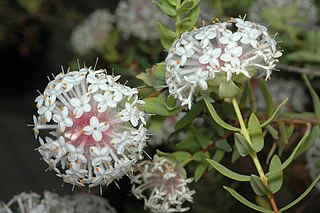
Pimelea avonensis is a species of flowering plant in the family Thymelaeaceae and is endemic to the south-west of Western Australia. It is a shrub with narrowly egg-shaped or elliptic leaves and clusters of white, tube-shaped flowers.
Pimelea biflora, commonly known as matted rice-flower, is a species of flowering plant in the family Thymelaeaceae and is endemic to south-eastern continental Australia. It is a prostrate, mat-forming shrub with elliptic leaves and dark red flowers always arranged in pairs on the ends of branches.

Pimelea bracteata, is a species of flowering plant in the family Thymelaeaceae and is endemic to the south-west of New South Wales. It is a shrub with narrowly egg-shaped to elliptic leaves and pendulous, pale green heads of pale yellow flowers.
Pimelea cinerea is a species of flowering plant in the family Thymelaeaceae and is endemic to Tasmania. It is a slender shrub with more or less elliptic leaves, and heads of white flowers surrounded by leaves.

Pimelea cracens is a species of flowering plant in the family Thymelaeaceae and is endemic to the southwest of Western Australia. It is an erect, spindly shrub with narrowly elliptic to egg-shaped leaves and creamy green to pale yellow flowers surrounded by 6 or 8 yellowish or pale green and reddish involucral bracts.
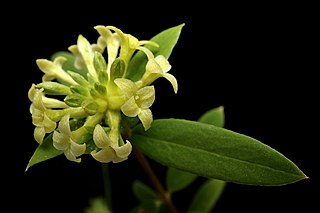
Pimelea cremnophila, commonly known as gorge rice-flower, is a species of flowering plant in the family Thymelaeaceae and is endemic to a restricted area of New South Wales. It is an erect shrub with narrowly elliptic to narrowly egg-shaped leaves arranged in opposite pairs, and groups of up to four flowers that are sometimes male-only or female-only.

Pimelea trichostachya, commonly known as annual riceflower, spiked riceflower or flax weed, is a species of flowering plant in the family Thymelaeaceae and is endemic to continental Australia. It is a slender, semi-woody, annual shrub with narrowly elliptic or linear leaves and densely hairy, white or yellow flowers and green, purple-tinged fruit. It is toxic to livestock.
Pimelea drummondii is a species of flowering plant in the family Thymelaeaceae and is endemic to near-coastal areas of southern Western Australia. It is an erect, slender shrub with narrowly elliptic or elliptic leaves arranged in opposite pairs, and white or cream-coloured flowers surrounded by 3 or 4 pairs of pale green to yellowish involucral bracts.















